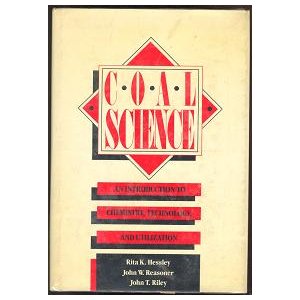

| COAL SCIENCE An Introduction to Chemistry, Technology, and Utilization Rita K. Hessley John W. Reasoner John T. Riley New York: John Wiley & Sons, June 1986 |
Rating: 4.5 High |
|||
| ISBN-13 978-0-471-81225-8 | ||||
| ISBN-10 0-471-81225-0 | 269pp. | HC | $? | |
All three authors are from the Department of Chemistry, Western Kentucky University, Bowling Green.
"Coal is the most plentiful energy resource in the United states. It has been, and will continue to be, the principal fuel used by electric utilities. As petroleum resource become more limited, the abundant coal resources will become more attractive for chemical feedstocks as well as sources of liquid and gaseous fuels." – Page v |
| Coal | Heat Value |
|---|---|
| Grade | (BTU/lb) 1 |
| Lignite B | 6,000 |
| Lignite A | 7,500 |
| Subbituminous C | 8,500 |
| Subbituminous B | 10,000 |
| Subbituminous A | 11,000 |
| High-volatile Bituminous C | 12,000 |
| High-volatile Bituminous B | 13,300 |
| High-volatile Bituminous A | 14,500 |
| Medium-volatile Bituminous | 15,200 |
| Low-volatile Bituminous | 15,500 |
| Semianthracite | 14,900 |
| Anthracite | 14,300 |
| Meta-anthracite | 13,600 |
There is a detailed table of contents. Here are the major divisions:
| 1. An Introduction to Coal and Coal Science | 1 |
| 2. The Petrology and Petrography of Coal | 40 |
| 3. The Organic Structure of Coal | 91 |
| 4. Coal Conversion | 129 |
| 5. The Analytical Chemistry of Coal | 182 |
| Index | 259 |
Each chapter ends with a summary and a list of references. There is much useful information in this book. Examples include:
Overall, I'd say this book is useful but suffers from the authors' attempt to cram too much into a single slim volume. Some tables are poorly designed and not very informative, in my opinion. Prime examples are actually Figures 5.12 and 5.13 on pages 241 and 242 respectively. They claim to give the "occurrence frequency" and the "concentration range" of elements in 13 raw coals; but they are arranged in the form of periodic tables of elements. Many of the values in Fig. 5.12 are given as either 0, 100 or "ND" (not determined.) Values in both figures are given as pure numbers; I assume they represent percentages, but this is never specified. And tables 5.8 & 5.9, on international classification of coal, are strictly for specialists. Also there are some grammatical and factual errors in the book. These are listed on my Errata page. Recommended, but not with top marks.

 To contact Chris Winter, send email to this address.
To contact Chris Winter, send email to this address.